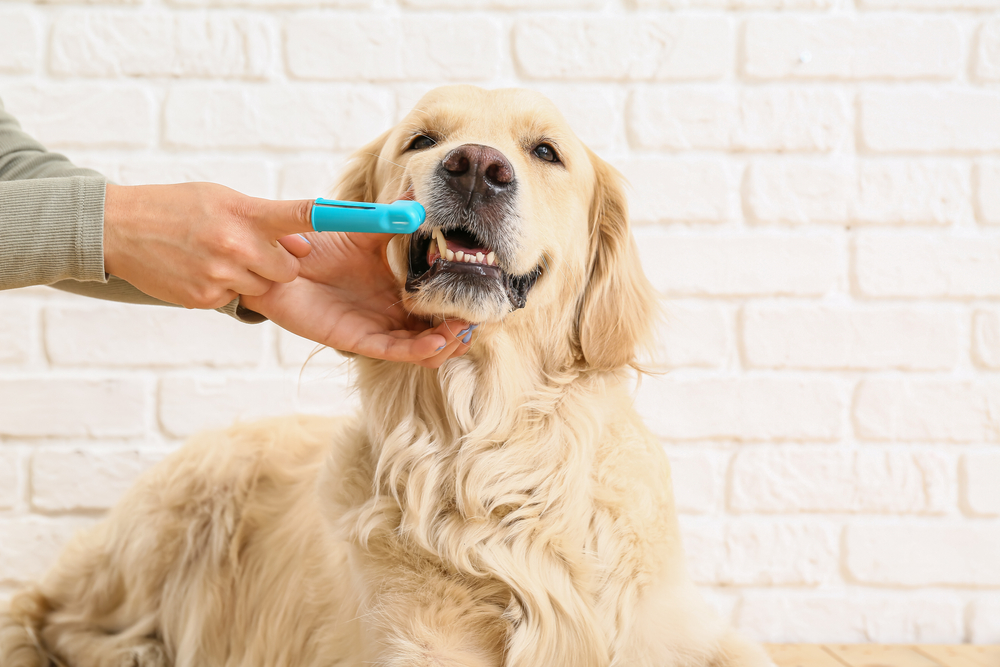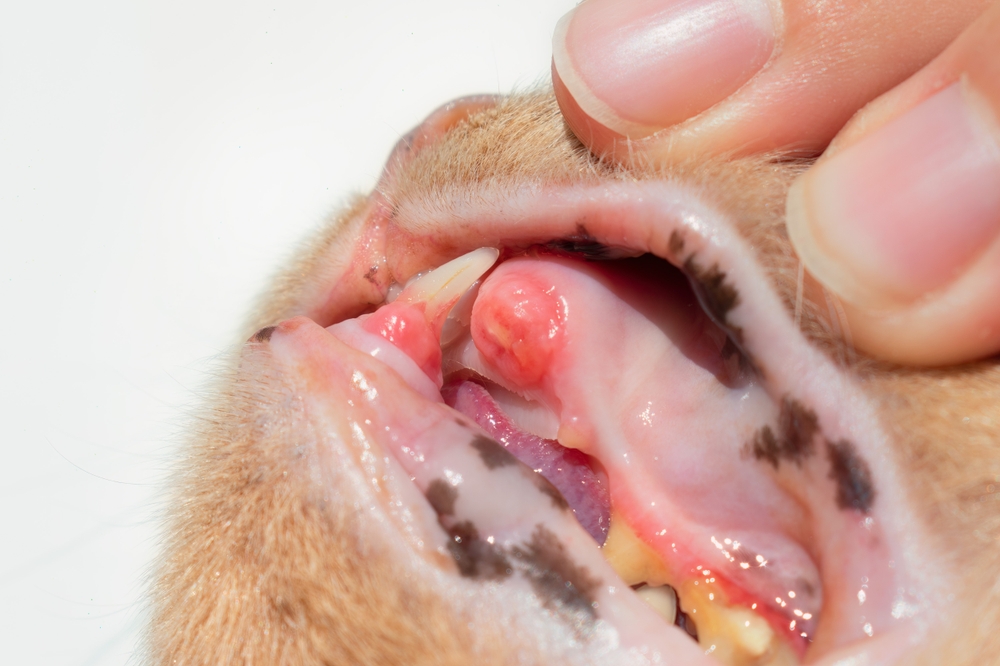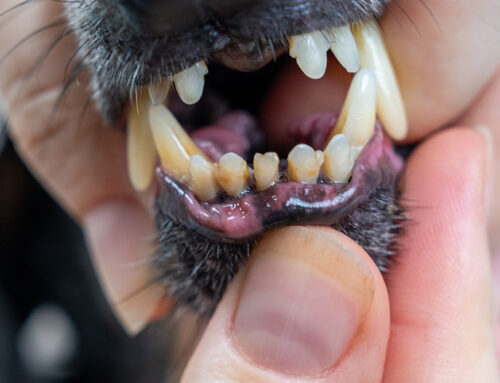Pet dental emergencies can be distressing for owners and pets alike, and you need to know how to recognize and respond in emergencies for your pet’s health and well-being. Therefore, the North Bay Veterinary Dentistry team has created this guide to common dental emergencies that includes tips on responding to an emergency and minimizing your pet’s risk. By understanding these key aspects, you’ll be better prepared and able to handle unexpected problems concerning your pet’s dental health.
Watch out! Dental emergency signs to watch for in pets
True dental emergencies are uncommon, but cause significant pain and discomfort and may lead to serious—sometimes life-threatening—complications. Often the first line of defense for an emergency is either your own primary veterinarian or an emergency clinic. Signs that could indicate your pet is having an emergent problem can include::
- Sudden appetite loss
- Significant or steady bleeding (e.g., frank blood (not blood-tinged saliva) near or around your pet’s mouth or nose, in their water or food dish, and on toys or bedding)
- Excessive drooling
- Exaggerated pawing at the mouth
- Facial swelling
- Difficulty opening or closing the mouth
- Holding their jaw in an abnormal position
- Jaw Chattering
- Unusually bad breath
These signs are common across a variety of different pet emergencies and illnesses, so your primary or emergency veterinarian must examine your pet to determine the urgency and severity of your pet’s health problem.
Common veterinary dental emergencies
Common pet dental emergencies include:
- Jaw fracture or facial trauma — Facial trauma can result after a blunt injury (e.g., hit by a car or object, dog attack) or from a deteriorative disease such as cancer or severe periodontal disease. These emergencies generally require immediate pain management and temporary stabilization, followed by corrective surgery (i.e., wiring, plating the fracture, or keeping their mouth in a closed position for healing over several weeks to restore proper function and prevent long term complications if it heals poorly. If an erosive disease process (e.g., cancer, dental disease) has caused your pet’s jaw injury, proper diagnosis and treatment, such as surgical excision, biopsy, and tooth removal, may also be necessary.
- Foreign body — Foreign body emergencies arise when pets chew on or swallow inappropriate items, which can range from penetrating seeds (e.g., grass awns) that enter through the gum tissue, to larger objects that injure the oral cavity (e.g., sticks or mulch), or string and yarn that wraps around the pet’s tongue or a tooth. Foreign items can cause penetrating trauma, affect normal eating and drinking, entrap the tongue (e.g., hollow rubber toys, bones), result in significant bleeding or disrupt blood flow to key structures, or become embedded below the tissue where they migrate to other body areas or form a localized abscess.
- Autoimmune and other miscellaneous disorders — Although less common, certain auto-immune or idiopathic disorders (e.g., masticatory muscle myositis, craniomandibular osteopathy, TMJ dysplasia) can compromise jaw function, and affected pets have difficulty opening or closing their mouth. Treatment depends on the cause of the condition, and how severely affected the individual is. Any time the jaw is locked in an open or closed position requires an emergent evaluation of your pet.
- Dental fracture or broken teeth —In general, most of the dental fractures that occur are not acute emergencies unless there is significant pain, or the sharp edge of a fractured tooth is causing damage to the cheeks, lips, or tongue. When a tooth fracture first occurs, your pet may experience some pain, and it is a good idea to visit your primary veterinarian for an evaluation and possible pain medication. If the pulp cavity—a narrow chamber in the tooth’s center that houses the pulp (the blood vessels and nerves)—is exposed, the tooth will eventually die and develop an abscess around the root (although it is difficult to predict when this will occur). If you know for sure when the tooth has broken, you may be able to keep the tooth alive by performing vital pulp therapy within 24 hours of the fracture occurring. Most often, though, we don’t know when the tooth actually broke. To prevent an abscess from forming, either extracting the tooth or performing root canal therapy is needed to keep your pet’s mouth healthy.
- Tooth root abscess – When a broken tooth is left too long, or sometimes when a tooth dies without any outward signs, it can “blow up” into an acute abscess- a collection of inflammation, pus, and swelling that may look like a very distinct lump, or may cause more diffuse swelling over the upper or lower jaw. If it is chronic, there may also be a sore on the skin or above the gumline in the mouth where the inflammation can drain from. If your dog has acute swelling, the immediate emergency therapy will be antibiotics and pain management, giving your pet time to then be able to later safely anesthetize them and treat the broken tooth.
Action plan: What to do during a pet dental emergency
If you suspect your pet is experiencing a veterinary dental emergency, try to stay calm and think through your next steps. Most dental emergencies are best evaluated first by your regular veterinarian or by an emergency clinic..
- Immediately contact your regular veterinarian or emergency clinic— If the emergency occurs after hours, contact the nearest 24/7/365 veterinary center for concerns such as active bleeding, severe pain, maxillofacial trauma, and inability to open or close the mouth..
- Do not give your pet anything by mouth — Unless instructed by a veterinarian, do not give your pet medications or attempt to force-feed your pet during an emergency, which may lead to choking or aspiration.
- Do not attempt to remove anything from your pet’s mouth — Painful pets may bite or snap out of fear and discomfort or accidentally choke on or swallow a trapped object. General anesthesia or sedation is often necessary to safely remove foreign items.
Preventing dental emergencies in pets

Accidents happen but, fortunately, many pet dental emergencies can be prevented or minimized by taking proper precautions and practicing diligent dental care, which includes:
- Visiting your veterinarian for oral health exams — Regular exams allow the veterinarian to monitor your pet’s oral health and identify small problems before they become severe (like broken and non-vital teeth, and periodontal disease).
- Supporting your pet’s dental health at home — At-home care tasks (e.g., toothbrushing, a dental diet) can reduce your pet’s periodontal disease risk and help you recognize early warning signs.
- Selecting safe chew toys — Supervise your pet’s playtime and remove worn or broken toys. Check out our safe chew toys article to determine what’s right for your pet.
Veterinary dental emergencies can be frightening, but the North Bay Veterinary Dentistry team can provide fast, knowledgeable, and compassionate care.






Leave A Comment